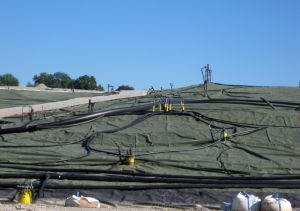St. Louis Post-Dispatch
by Deb Peterson

It’s time for state and federal officials and privately ownedRepublic Services to stop giving residents in the West Lake and Bridgeton landfill areas the runaround.
And it’s way past time for Gov. Jay Nixon to stop muzzling his employees and contractors — who are paid with public dollars — so they can reassure the public about health concerns related to the landfills.
In the latest we’ve-got-a-secret episode, a report by a consultant for the Missouri Department of Natural Resources says that a fire smoldering beneath the surface of the Bridgeton Landfill is expanding and moving closer to radioactive waste in the adjacent West Lake Landfill.
This report runs precisely counter to recent assurances from Republic Services, which owns and operates the landfills, that the smoldering landfill is at “a managed state.”
The U.S. Environmental Protection Agency backs Republic’s view. Karl Brooks, director of the EPA’s Region 7 office, said Monday that his agency has no evidence from monitoring data that the fire is moving in the direction that the consultant’s report concludes it is moving.
So the state consultant sees a problem where Republic and the EPA don’t. Who’s right? Don’t worry your pretty little head about it.
Part of the problem is that scientists and science-crats are experts in obfuscation. For example, they don’t call what’s happening at the Bridgeton Landfill an underground fire. It would be a fire if it were exposed to oxygen, but since it’s not, they call it an “SSE” — “subsurface smoldering event.”
Someone who can speak plain English needs to get involved.
The state’s consultant, Todd Thalhamer, issues periodic reports about the landfill. Since he does not have a vested financial interest in the sites, and isn’t an elected or appointed official, he appears to be an ideal source to shed much-needed light on what is going on beneath the ground at the landfills.
Unfortunately, his contract with Mr. Nixon’s Department of Natural Resources specifically forbids him from talking to reporters. Too bad the fire — excuse us, the smoldering event — isn’t as carefully controlled as the information flow.
The Post-Dispatch’s Jacob Barker and Blythe Bernhard wrote about Mr. Thalhamer’s report last week, noting that it contains the only data that counter Republic’s optimistic views.
It’s difficult for non-scientists to sort through the conflicting data. They can’t know whether there is anything to fear from the fire at the site, or if there are dangerous levels of cancer-causing compounds, or what happens if the fire migrates into areas where radioactive waste was buried long ago.
The public has a right to straight answers from an independent source. That’s partly what regulatory agencies are supposed to do. When they operate unshackled, they can answer questions, reassure people that all is well (or not) and occupy the space between competing financial interests. Mr. Nixon should let the DNR’s expert speak.
And then there’s the now-you-see-it-now-you-don’t plan to build a barrier between the adjacent landfills. Mr. Brooks wrote in a commentary for the Post-Dispatch in February that the barrier’s design was nearly complete and that “construction should begin soon.”
Later, the EPA announced work would begin in June. It didn’t. It hasn’t begun in September. In fact, it won’t begin for at least 18 months.
Mr. Brooks says his comment was referring to “pre-construction” activities, such as air monitoring. He also said his agency has now met with Federal Aviation Administration officials and Lambert Airport Director Rhonda Hamm-Niebruegge, who are concerned about the potential for disruption in air safety. If you dig up buried waste, birds could see a smorgasbord, and the landfills lie on the western approach to the airport.
The Nuclear Regulatory Commission investigated the site and published a report on it in 1977. The EPA designated it a Superfund site in 1990, making it eligible for special federal funding to clean up the nation’s most hazardous waste sites. Twenty-four years later, new agencies are being brought into the discussion, and the future is as hazy as ever. When will the public get some straight answers?
